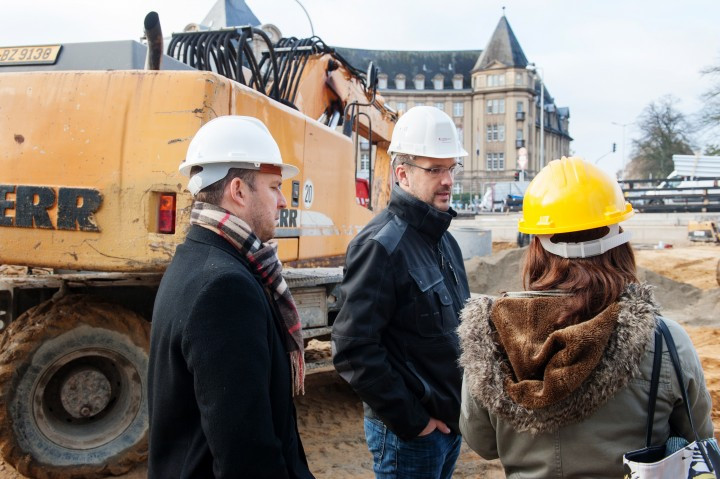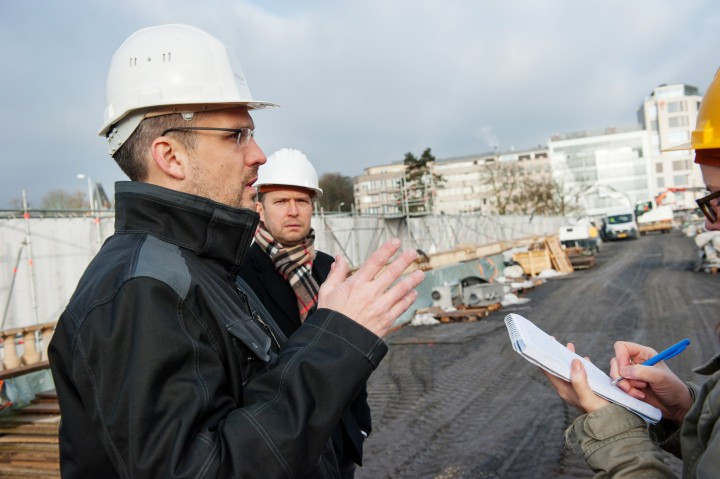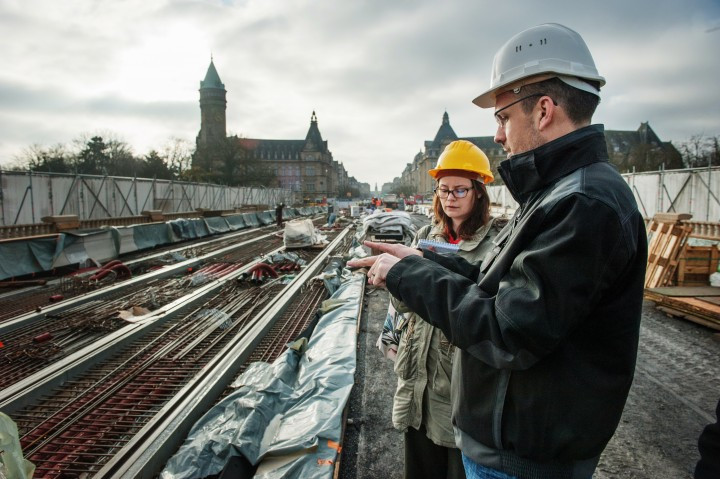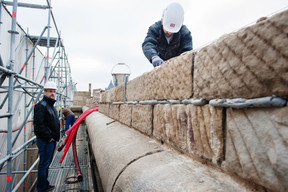Behind the giant tarpaulin, which keeps dust and sound contained, around 80 people were working feverishly six days a week to meet the mid-March reopening deadline when Delano visited on 17 February.
“The tarpaulin will start coming down on 1 March then, from 15 March we will start removing the scaffolding,” project manager Marc Ries of the Highways Department told Delano, explaining it will take four to six months to remove the 200,000 cubic metres of scaffolding required to carry out the work.
Among the last jobs to complete before the bridge reopens is the installation of network cable tubes for things like telecommunications and electricity. Colourful plastic pipes protrude from the ground like silly string.
“These are to house replacements and reinforcements of the existing network, for the next 50 years,” Ries said, adding: “It’s quite a piece of work!”
With piles of wet sand and rows of exposed metal for the tram tracks, the bridge is still some way off completion but these last tasks are nothing compared to the massive work that has already been carried out in reinforcing the cracked archways. Temporary stabilising rods were installed in 2003 but they alone were not enough to ensure the bridge’s long-term viability.
The latest renovation saw most of the bridge, except for the arches, dismantled stone by stone, rebuilt and reinforced with stainless steel rods.
“Thousands of stones were dismantled, we numbered each of them. It was a big puzzle of pieces of stone. We stored them in Contern, cleaned them and then brought them back and put them in the right order,” Ries said.
Before the tram is operational, these tracks will be used as bus lanes
The scale of the renovation is epic but there was never any question of replacing the bridge, which is affectionately known to Luxembourgers as the “nei” or new bridge.
Designed by French engineer Paul Sejourné and completed in 1903, it was the world’s biggest stone bridge, costing a fifth of the state’s then total budget, Ries explained. Afterwards, engineers switched to using steel, making stone bridges on this scale a rarity nowadays.
“I’m very proud to be able to work on this project. It’s something that you don’t get to do more than once in your career,” Ries said.
During the renovations, workers found tiny markers from their predecessors, some of which carved their initials into stones, or left finger prints in the mortar.
Other curious finds include the excavation of a shooting range from Fort Bourbon on the Spuerkeess side of the bridge and the “Jost” wall where the cycle path meets the road on the other side.
The bridge was partially dismantled with each stone numbered
In addition to reinforcing the arches, the renovation enabled workers to widen the bridge, by 75 centimetres on each, an exercise last carried out in 1960.
“We expanded the bridge to make the pavements wider and give more space to pedestrians,” Ries said. The number of traffic lanes will be reduced from three to two to allow space for the two new tram lines.
Ries explained that before the tram line opens, the tracks will be used by normal buses travelling into the city centre. When the tram becomes operational, this traffic will be redirected along the viaduct.
A modern gallery is seen through an original archways as old meets new
Other improvements include the replacement of the mishmash of balustrades, with 500 identical balustrades made from stone sourced in Luxembourg. Keen observers may also note that the insignias of a lion and the heraldry of the Nassau family on opposing sides of the bridge have also been replaced with almost exact replicas.
Perhaps, the most dramatic transformation is the newly created cycle path suspended directly beneath the bridge. The platform offers a rare view of the underbelly of the bridge, its buttery stone and a close look at the incredible craftsmanship.
While it looks almost complete, Ries explained there is still much to be done here. That is why cyclists and pedestrians must wait until later in 2017 to test it out for themselves.


































